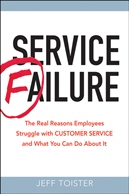ASTD 2013 ICE Conference Re-cap
 Jeff Toister
Jeff Toister  Tuesday, May 28, 2013 at 11:37AM |
Tuesday, May 28, 2013 at 11:37AM | I attended the ASTD 2013 International Conference & Exposition in Dallas, Texas last week. This is the premier conference for Training and Development professionals with an estimated 9,000 people in attendance. This conference is always important to me since training is at the core of what I do to help clients improve customer service.
Attending a conference like this can feel like drinking from a fire hose so I’ve put together a summary of my top take-aways from the conference.
Conference Overview
You may want to start by familiarizing yourself with the conference.
Another great resource is a collection of David Kelley’s curated resources from the ASTD 2013 Backchannel.
Conference Themes
These are the top three themes I took away from the conference.
Theme #1: Where's the Performance?
The whole point of training should be to help people perform their jobs better. This topic was conspicuously lacking at the conference.
The conference was certainly rich in content. There were wonderful sessions, keynotes, and vendors sharing the latest trends in learning. The place was abuzz with technology. You had to literally run and hide if you wanted to avoid networking with amazing people.
The missing piece was why any of this should matter. How can we do a better job of helping the employees we serve improve their performance?
Theme #2: Problem-centered Learning
Most training courses today are built around a specific collection of content. A problem-centered learning approach builds training around a specific problem. The content is only introduced (or discovered by participants) as they need it to help solve a problem.
For example, let’s say you wanted to learn about geography. You could take a course that taught you all sorts of geographic facts. Or, you could try playing a round of GeoGuessr where you are shown a random location and must try to locate it on a world map. The game-based approach challenges you to develop your geography skills by examining clues in the picture to narrow down the location. (Warning: this game is addictive, especially if you try to beat my high score of 27,151.)
This theme promised to move us closer to performance if we can build training around real work challenges. For example, a customer service training program could be designed around around finding ways to improve customer satisfaction ratings. This could make the training much more useful than simply providing a set of generic customer service skills.
Theme #3: Technology
ASTD released its newly updated competency model in 2013. One of the biggest changes was the introduction of Learning Technologies as an area of expertise for the Training & Development Profession. This recognizes the growing influence of technology in how we deliver training and support our employees’ performance.
Two big technology themes at the conference were social and mobile learning. Social learning is a broad term, but at the conference it primarily meant using social technology like Twitter to help foster learning. Mobile referred to learning from a mobile device such as a phone or tablet. In many ways, conference attendees were doing both since we could access most of the session materials from a mobile application and many of us were exchanging ideas and resources via Twitter throughout the conference.
Another area where I see technology growing is the use of webinars for training. Most webinars today are delivered in a boring death-by-lecture format, but they can actually be highly engaging and interactive if facilitated correctly.
For example, I recently facilitated a customer service training program entirely via webinar for a call center client. The highly interactive class was split into one-hour sessions so participants could apply what they learned before focusing on a new skill. The sessions were highly rated and, more importantly, they used what they learned to improve customer service.
If you attended the conference, or tuned in via Twitter, what were your take-aways?



